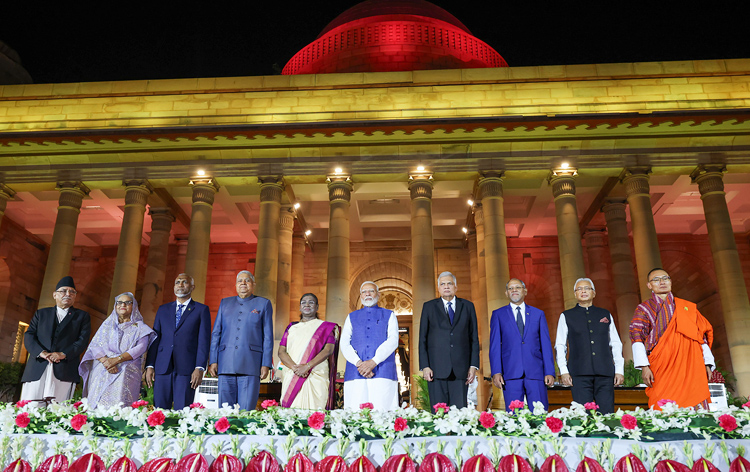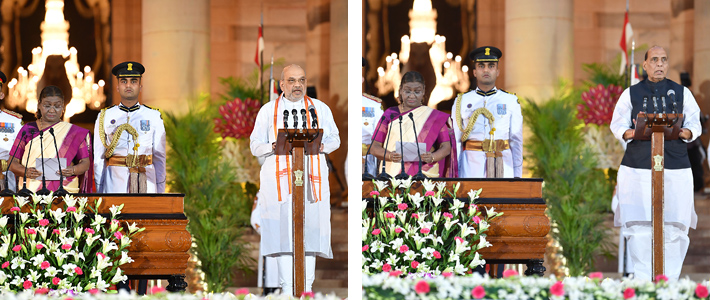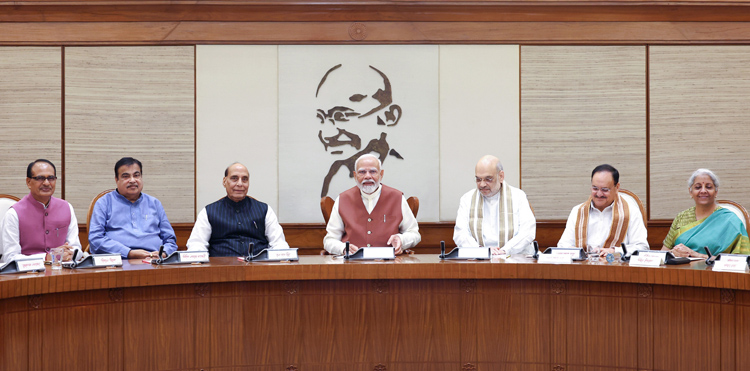INDIAN ARMED FORCES CHIEFS ON OUR RELENTLESS AND FOCUSED PUBLISHING EFFORTS

The insightful articles, inspiring narrations and analytical perspectives presented by the Editorial Team, establish an alluring connect with the reader. My compliments and best wishes to SP Guide Publications.

"Over the past 60 years, the growth of SP Guide Publications has mirrored the rising stature of Indian Navy. Its well-researched and informative magazines on Defence and Aerospace sector have served to shape an educated opinion of our military personnel, policy makers and the public alike. I wish SP's Publication team continued success, fair winds and following seas in all future endeavour!"

Since, its inception in 1964, SP Guide Publications has consistently demonstrated commitment to high-quality journalism in the aerospace and defence sectors, earning a well-deserved reputation as Asia's largest media house in this domain. I wish SP Guide Publications continued success in its pursuit of excellence.
NDA 3.0 and Defence Allocations
With India already a $5 trillion economy and aiming for $7 trillion by 2030, an annual defence budget of 4-5 per cent of GDP is needed through the next decade.
 |
The Author is Former Director General of Information Systems and A Special Forces Veteran, Indian Army |

The new Indian Government led by Prime Minister Narendra Modi has been sworn in on June 9, 2024. The Union Defence Minister, Home Minister, Foreign Minister and Finance minister remain unchanged. The Parliament is likely to meet on July 18.
Amid the prevailing geostrategic dynamics and the race for global domination, the threats to India are also rising. The China-Pakistan nexus is growing stronger and has extended into the maritime domain including China supplying submarines to Pakistan. Heads of States of some of India's immediate neighbourhood attended the swearing in of the new government but many of them are being drawn further into China's strategic sphere; new Nepalese coins with maps claiming Indian Territory and Maldives ordering review of Indian projects are just two examples.
The China-Pakistan nexus is growing stronger. Heads of States of some of India's immediate neighbours attended the swearing-in of the new government but many are being drawn further into China's strategic sphere.
It is important to study the War in Ukraine that has become a laboratory for high-end technological military applications. Why Ukraine is losing 10,000 drones every month on an average. How American weapons and systems, including Excalibur guided 155mm artillery rounds, HIMARS precision missile, GPS-guided bombs and systems, and AI-aided Skydio drones have fared poorly due to Russians employing Electronic Warfare (EW), Artificial Intelligence (AI) and Cyber Warfare. How Russia's maximum casualties in the first two weeks of operations fell dramatically, thereafter averaging to 10 per cent of casualties suffered by the Ukrainian forces. The potential strategic benefit of integrating AI with EW and cyber has the potential to reshape the landscape of future warfare. This is what we are likely to face in the next war with China.

Similarly, the Israel-Hamas war has been witnessing Israel's AI-enabled bombings under the 'Lavender Program' and the intricacies of the extensive tunnel warfare, both of which need to be studied. It would also be useful to examine how the Houthi have already shot down (kinetically or using EW?) six American MQ-9 Reaper drones, since we are also acquiring similar drones.
We need credible capabilities vis-à-vis China in space, EW-AI-Cyber, and long-range vectors (rockets and missiles). The 'Rocket Force' must be speedily formed, and we must also have tactical nuclear weapons (TNWs) and their delivery systems as part of our nuclear deterrence.
China has been increasing its activities in the Indian Ocean Region (IOR) and is upping the ante in the South China Sea. The establishment of an Information Support Force (ISF) is also significant. China's hectic pace of consolidation along the Line of Actual Control (LAC) and deployment of J-20 fighter aircraft, AWACs and air defence systems at Shigaste adjacent to the India-China-Bhutan junction indicates Beijing's aggressive designs.
Consequently, we need credible capabilities vis-à-vis China in space, EW-AI-Cyber and an Indian version of 'Assassin's Mace' weapons including long-range vectors (rockets and missiles). The 'Rocket Force' must be speedily formed. In addition, we must also have tactical nuclear weapons (TNWs) and their delivery systems as part of our nuclear deterrence.


In the above backdrop, we urgently need a 'potent' national security strategy, the military security portion of which must include the nuclear, conventional, hybrid and unconventional aspects. Moreover, to establish credibility of any deterrence, we need to demonstrate it. For example, we need to exact cross-border revenge for every individual terror attack in J&K – certainly not once in 10 years like the 'surgical strike'.
A 'potent' national security strategy is urgently needed, incorporating nuclear, conventional, hybrid, and unconventional aspects. To establish credible deterrence, we need to demonstrate it.
Our military has equipment voids and continues to hold some obsolete equipment. The Indian Air Force is quite short of the authorised number of operational fighter squadrons. The Navy is grossly short of underwater capabilities. The number of SSBNs needs to be increased and minesweeping capability established. All these shortages need to be addressed holistically, not piecemeal.
Defence allocations must be seriously addressed by the new NDA government, especially since economic power by itself does not make the nation a super power. Witness how much Japan, which does not even have a land border with China, has had to hike its defence budget in the last two years. With India already a $5 trillion economy and aimed at $7 trillion by 2030, an annual defence budget of 4-5 per cent of GDP is needed through the next decade if we want to catch up/overtake China. When Charles De Gaulle became President of France, he pegged the defence budget at 10 per cent for the next few years, turning France into a superpower.

The Theatre Commands (TCs) are work in progress. There appears to be a move to announce them soon. Obviously the overall assets, including those of the IAF and Army's reserve formations, would be taken into account. At the same time, ramifications of grouping the Siachen-Kargil area with either the China-specific or Pakistan-specific TC needs to be carefully weighed.
Indigenisation of the defence sector should be top priority. We cannot afford to keep relying on imports. The focus should be towards "complete privatisation", as is the case in counties having modern militaries. The private sector including startups and MSMEs should be allowed to break the umbilical cord with the DRDO even after they come up with new innovations. Restructuring of the DRDO is underway but if it generally retains the same hierarchy, oversight and work culture then nothing much is likely to be gained; eventual privatisation should be examined.
Indigenisation of the defence sector should be a top priority. The focus should be towards complete privatisation.
The Agnipath system of Agniveers has unfortunately become a political issue and some tweaking is in the air, like increasing the percentage of absorption of Agniveers into the military. The system has serious implications in degrading the man behind the machine and in turn for national security. Moreover, Agniveer-equivalents in the Russian and Ukrainian forces have proved to be cannon fodder in the Ukraine War.
A 3-star veteran recently wrote, "The scheme (Agnipath) has now become a political issue. Do those who rammed it in and gave false justification realise the problems the fighting units have and how such wrong policies can result in casualties and defeats. Ask the young officers, JCOs and NCOs of these units. The Armed Forces are not employment agencies. As per estimation, Agniveers will be about 40 per cent of the total Army strength in the next 10 years; imagine 40 per cent with average service of 2-3 years in any combat unit and without any specialist training, but it is finally the politicians (none of whom will send their children to become Agniveers) to cancel this scheme because the military hierarchy is unlikely to protest, looking at the trend in recent years".





